To create a wedding photography and videography shot list for a small wedding, start by understanding your timeline and noting key moments. Compile essential pre-ceremony shots, including venue details and getting-ready moments. List must-have ceremony shots like the bride's entrance and first kiss. Plan for intimate couple moments and family group photos. Incorporate unique venue features and personal touches in your list. Create a detailed shot schedule and communicate it clearly with your photography team. Don't forget to capture candid guest interactions and reception highlights. By following these steps, you'll guarantee no precious moment goes undocumented on your special day.
Key Takeaways
- Understand the wedding timeline and allocate time for key moments like getting ready, ceremony, and reception.
- Create a list of essential shots, including pre-ceremony details, first look, and intimate couple moments.
- Plan family and group photos, coordinating with the couple for desired combinations and ideal timing.
- Capture important reception highlights such as first dance, speeches, and cake cutting.
- Document candid guest interactions and unique venue features to add depth to the wedding story.
Understand Your Wedding Timeline

Before diving into your shot list, it's crucial to have a clear understanding of your wedding day timeline. Knowing the schedule of events will help you plan your photography and videography coverage effectively.
Start by obtaining a detailed itinerary from your wedding planner or coordinator. This should include key moments like getting ready, the ceremony, cocktail hour, reception, and any special traditions or activities.
Review the timeline carefully, noting the duration of each event and the changes between them. Consider factors like lighting conditions throughout the day and how they'll affect your shots.
Identify potential challenges, such as tight time constraints or venue restrictions, and plan accordingly.
Don't forget to allocate time for formal portraits and group photos. Coordinate with your couple to determine their priorities and any specific shots they want.
Be sure to factor in travel time between locations if applicable.
Essential Pre-Ceremony Shots

With your timeline in hand, it's time to focus on capturing those pre-ceremony moments. These shots set the stage for the day and showcase the anticipation building up to the main event.
Start by photographing the wedding venue's exterior and key interior spaces before guests arrive. This includes the ceremony site, reception area, and any unique architectural features.
Next, document the bride and groom's preparations separately. Capture the bride getting her hair and makeup done, putting on her dress, and sharing moments with bridesmaids or family members.
For the groom, photograph him getting dressed, adjusting his tie, and interacting with groomsmen. Don't forget to capture important details like the rings, bouquets, boutonnières, and any sentimental items.
If possible, arrange a "first look" session where the couple sees each other before the ceremony. This provides an intimate moment and great photo opportunities.
Ceremony Must-Haves
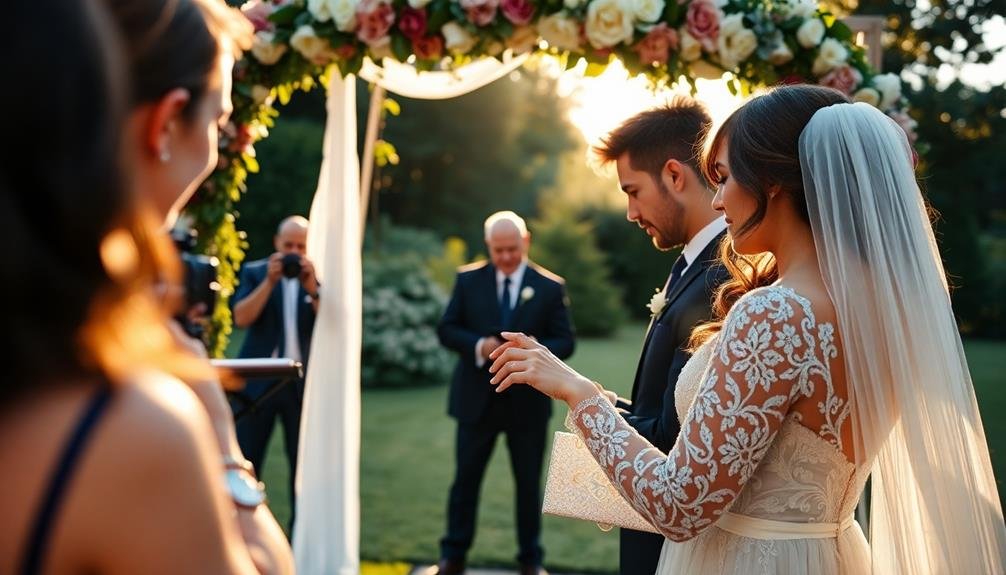
As you capture the ceremony, focus on the essential moments that tell the couple's story.
Be sure to document the bride's entrance, the exchange of vows and rings, and the first kiss as newlyweds.
Don't forget to include key family shots during the ceremony, such as parents' reactions and any special traditions unique to the couple's cultural background.
Essential Ceremony Moments
The heart of any wedding lies in its ceremony, and capturing these pivotal moments is vital for a wedding photographer.
To guarantee you don't miss any essential shots, focus on these key moments:
Start with the processional, capturing the bride's entrance and the groom's reaction. Document the exchange of vows, making sure to get close-ups of emotional expressions and hand gestures.
Don't forget to capture the ring exchange, zooming in on the hands and rings. The first kiss as a married couple is a must-have shot, so be ready to capture it from multiple angles if possible.
Throughout the ceremony, pay attention to the couple's interactions, their families' reactions, and any special rituals or traditions.
Capture the officiant during key moments and any readings by friends or family members. Don't overlook the signing of the marriage certificate, as it's an important legal aspect of the day.
Key Family Shots
Family shots during the ceremony are essential for preserving the emotional journey of the couple's closest relatives. As you capture these moments, focus on the parents' reactions when the bride walks down the aisle and during the exchange of vows.
Don't forget to include shots of siblings, grandparents, and any special family members in attendance. Be certain to capture the father giving away the bride, as well as the mother's tearful smile.
Look for tender moments between family members, such as a reassuring hand squeeze or a shared glance. If there are step-parents or blended families involved, be sensitive to these dynamics and make sure you're including everyone appropriately.
During key ceremony moments, scan the front rows for emotional reactions from immediate family members. Capture their expressions of joy, pride, and perhaps a few happy tears.
If children are involved in the ceremony, such as ring bearers or flower girls, document their participation and the family's reactions to them.
Remember to be discreet and unobtrusive as you photograph these intimate family moments. Your goal is to authentically capture the love and support surrounding the couple on their special day.
Capturing Intimate Couple Moments

Capturing intimate couple moments is one of the most essential aspects of wedding photography. These shots showcase the love and connection between the newlyweds, creating timeless memories. To capture these moments, you'll need to be observant and ready to shoot at a moment's notice.
Start by finding a quiet location away from guests, allowing the couple to relax and be themselves. Encourage natural interactions by giving minimal direction and letting them connect organically. Capture stolen glances, gentle touches, and genuine laughter.
Don't forget to photograph the couple's hands, focusing on their wedding rings and interlaced fingers.
Use a variety of angles and compositions to add visual interest. Try shooting through objects like foliage or doorways to create depth and framing. Utilize natural light whenever possible, positioning the couple near windows or in outdoor settings with flattering light. For indoor locations, consider using off-camera flash to create a soft, romantic atmosphere.
Remember to capture both wide shots that show the couple in their surroundings and close-ups that highlight intimate details. Be patient and allow moments to unfold naturally, as some of the best shots come from unplanned interactions between the newlyweds.
Family and Group Photos

While intimate couple moments are cherished, wedding photography isn't complete without documenting the larger family dynamics. Family and group photos are essential for capturing the collective joy and support surrounding the newlyweds.
Start by creating a list of key family groupings, including immediate family, extended family, and close friends. Coordinate with the couple to identify any special combinations they want, such as grandparents with grandchildren or siblings-only shots.
Plan these photos during a specific time slot, ideally after the ceremony when everyone's dressed and emotions are high. Choose a location with ample space and good lighting. Use a wide-angle lens to accommodate larger groups and guarantee everyone's in focus.
Direct guests efficiently, starting with the largest groups and working your way down to smaller combinations. Position people in a way that showcases their relationships and creates visual interest.
Don't forget to capture candid moments between formal poses. These often reveal genuine emotions and interactions. Be mindful of family dynamics and sensitivities, especially in cases of divorced parents or complex relationships.
Reception Highlights
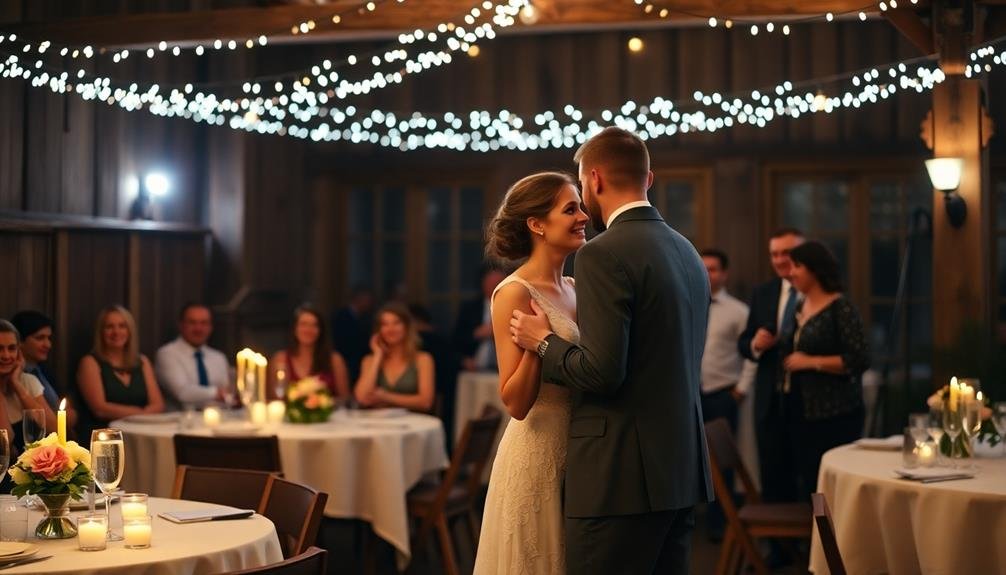
As you shift to capturing the reception highlights, focus on three key moments.
Start with the couple's first dance, ensuring you catch their expressions and any special moves.
Next, be ready to photograph the emotional speeches and celebratory toasts from family and friends.
First Dance Moments
The first dance marks a pivotal moment in the wedding reception. As a photographer or videographer, you'll want to capture this intimate and emotional scene from various angles.
Start by positioning yourself to get a wide shot of the couple as they take the dance floor. This establishes the setting and atmosphere.
Move in closer to capture the couple's expressions and interactions. Focus on their faces, hands, and body language to convey the emotions of the moment.
Don't forget to capture the reactions of family and friends watching from the sidelines.
Use different focal lengths to add variety to your shots. A telephoto lens can help you zoom in on details without intruding on the couple's space.
Consider using a wide-angle lens to capture the entire dance floor and the surrounding guests.
If possible, coordinate with the venue's lighting technician to guarantee ideal lighting conditions.
Experiment with different angles, such as shooting from a low position or finding an elevated vantage point.
Remember to capture both still images and video footage to provide a thorough record of this special moment.
Speeches and Toasts
Capturing the essence of speeches and toasts is essential for preserving the emotional highlights of a wedding reception. As a photographer or videographer, you'll want to focus on both the speakers and the reactions of the couple and guests.
Position yourself strategically to capture different angles and perspectives throughout these moments.
When shooting speeches and toasts, consider these key elements:
- The speaker's facial expressions and gestures
- The couple's reactions, including laughter, tears, and embraces
- Guest reactions, particularly family members and close friends
Be prepared to move quickly and quietly to capture candid moments. Use a longer lens to maintain distance and avoid disrupting the intimate atmosphere.
Pay attention to the lighting conditions, as speeches often occur during dimly lit portions of the reception. Adjust your camera settings accordingly to guarantee clear, well-exposed shots.
Don't forget to capture the clinking of glasses, raised toasts, and any unique traditions specific to the couple's cultural background. These details add depth to your visual storytelling and help create a thorough record of the wedding day's most heartfelt moments.
Cake Cutting Ceremony
Cake cutting, a time-honored wedding tradition, marks a pivotal moment in the reception. As a photographer or videographer, you'll want to capture this sweet event from multiple angles.
Start by positioning yourself to get a clear shot of the couple approaching the cake table. Ascertain you've got good lighting and a clean background.
When the couple begins cutting the cake, focus on their hands and faces. Capture their expressions as they work together to slice that first piece.
Don't forget to zoom in on the cake itself, showcasing its design and any personalized toppers. As they feed each other, be ready for potential playfulness or tender moments.
Remember to capture reactions from family and guests. Their emotions often mirror the couple's joy. If there's a cake-smashing moment, be prepared to catch it quickly.
After the main event, get some shots of the cake being served to guests.
Throughout the ceremony, vary your shots between wide angles that capture the entire scene and close-ups that highlight details. If you're working with a second shooter, coordinate to ascertain you're covering different perspectives.
Detail Shots
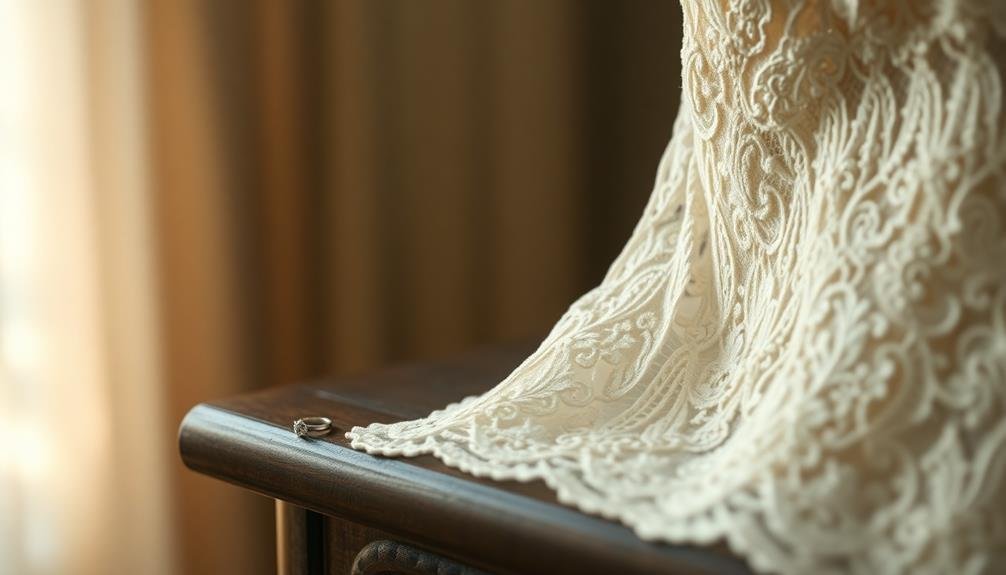
Focused on the finer elements, detail shots bring the intricate beauty of a wedding to life. These images capture the small, often overlooked aspects that make each celebration unique. As you plan your shot list, consider the personal touches the couple has incorporated into their day.
Don't forget to photograph the rings, both individually and together. Capture the intricate details of the bride's dress, including lace patterns, beadwork, and buttons. The groom's attire deserves attention too—focus on cufflinks, tie clips, and boutonnières. Remember to shoot the bride's bouquet, paying special attention to its composition and any sentimental items attached.
Other important detail shots include:
- Invitation suite and stationery
- Table settings and centerpieces
- Wedding favors and guest book
As you photograph these elements, experiment with different angles and lighting to highlight textures and colors. Use macro lenses for extreme close-ups that reveal hidden intricacies.
When possible, incorporate meaningful backgrounds or settings that tie the details to the overall wedding theme. By carefully documenting these small yet significant aspects, you'll create a thorough visual story that the couple will treasure for years to come.
Candid Guest Interactions

The heart of any wedding lies in the genuine moments shared between guests. Capturing these candid interactions will add depth and authenticity to your wedding album. Keep your camera ready and your eyes peeled for laughter, hugs, and animated conversations.
Look for groups of guests mingling during cocktail hour or reception downtime. These moments often yield the most natural and relaxed shots. Don't forget to capture cross-generational interactions, like grandparents chatting with young children or old friends reuniting.
Pay attention to the dance floor, where you'll find plenty of spontaneous, joyful moments. Capture guests letting loose, singing along to favorite songs, or sharing intimate slow dances.
Also, keep an eye out for emotional reactions during key moments like speeches or the couple's first dance.
Remember to be discreet and use a longer lens to avoid disturbing these natural interactions. If you're using flash, consider bouncing it off walls or ceilings for a softer, less intrusive light.
First Look Alternatives

If you're not keen on a traditional first look, consider alternatives that capture intimate moments before the ceremony.
You can arrange for private moments with parents, siblings, or best friends, creating emotionally charged photo opportunities.
Alternatively, explore creative group reveal ideas, such as a coordinated blindfold removal or a dramatic curtain drop, to add a unique twist to your wedding album.
Private Moments Before Ceremony
Excitement builds as the wedding day unfolds, and couples who choose not to have a traditional "first look" can still capture intimate moments before the ceremony.
These private moments offer a chance to document the bride and groom's individual emotions and preparations without seeing each other.
Consider photographing the couple in separate locations, capturing their anticipation and nerves. You might shoot the bride getting her final touches done or the groom adjusting his tie.
Look for candid moments that showcase their personalities and the emotions of the day.
Don't forget to capture interactions with family members and friends during this time. These shots can include:
- A parent helping the bride into her dress
- Groomsmen sharing a toast
- Bridesmaids laughing together while getting ready
As the ceremony approaches, focus on the couple's final moments of reflection.
Capture them reading letters from each other, exchanging gifts through a door, or sharing a phone call without seeing one another.
These images will tell the story of their last moments as single individuals before joining together in marriage.
Creative Group Reveal Ideas
While private moments before the ceremony capture individual emotions, creative group reveal ideas offer a fresh twist on the traditional first look. These alternatives can involve more family members and friends, creating a memorable shared experience.
Consider a "circle reveal," where the couple stands back-to-back in the center of a circle formed by their loved ones. On cue, they turn to face each other, surrounded by the joyful reactions of their guests.
Another option is the "staircase reveal," where one partner waits at the bottom while the other descends. This creates a dramatic moment that's perfect for photos and video.
For a more intimate group reveal, try the "door divide." Place the couple on opposite sides of a door, with close family members gathered around. As they open the door, you'll capture not only their reactions but also those of their nearest and dearest.
If you're working with a unique venue, incorporate its features into your reveal. Use archways, gardens, or scenic backdrops to stage a group reveal that showcases both the couple and the location.
Remember to communicate your plans clearly with all participants to guarantee smooth execution and genuine reactions.
Unique Venue Features
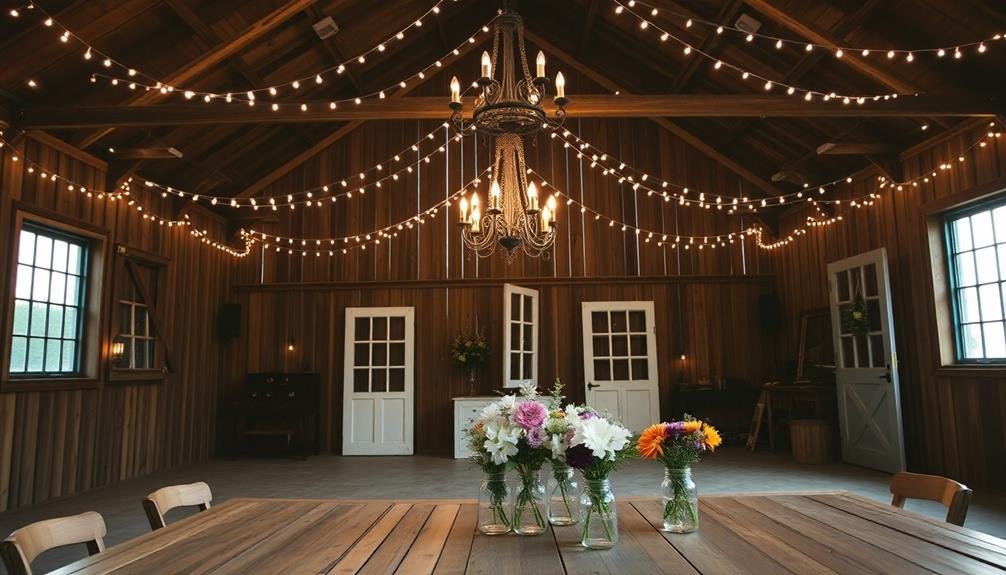
Every wedding venue has its own distinctive charm and features that set it apart. As a photographer or videographer, it's your job to capture these unique elements that make the location special. Before the big day, scout the venue and identify standout features that could serve as perfect backdrops for photos or add visual interest to your shots.
Look for:
- Architectural details like arches, columns, or intricate woodwork
- Natural elements such as gardens, water features, or scenic views
- Distinctive lighting fixtures or stained glass windows
When you've identified these unique features, incorporate them into your shot list. Plan to capture the couple, wedding party, and guests interacting with these elements throughout the day. For example, you might position the bride near an ornate doorway for her solo portraits or use a grand staircase for a dramatic group shot of the wedding party.
Don't forget to take into account how these features change throughout the day. A fountain that sparkles in the sunlight might become a magical, lit-up focal point at night.
Incorporating Personal Touches

As the big day approaches, it's crucial to capture the unique elements that make each wedding special. Personal touches are what set one wedding apart from another, and you'll want to guarantee these details are documented.
Start by discussing with the couple any sentimental items they plan to incorporate, such as family heirlooms, handmade decorations, or custom-designed accessories.
Create a list of these personal elements and plan specific shots to highlight them. For example, if the bride is wearing her grandmother's necklace, schedule a close-up shot to showcase its significance.
Don't forget to capture DIY projects, like hand-painted signs or personalized favors. If the couple has included symbolic rituals or cultural traditions, make certain to document these moments as well.
Consider the couple's shared interests or hobbies and how they might be represented in the wedding. This could include themed decorations, unique cake toppers, or even unexpected entertainment choices.
Creating a Shot Schedule
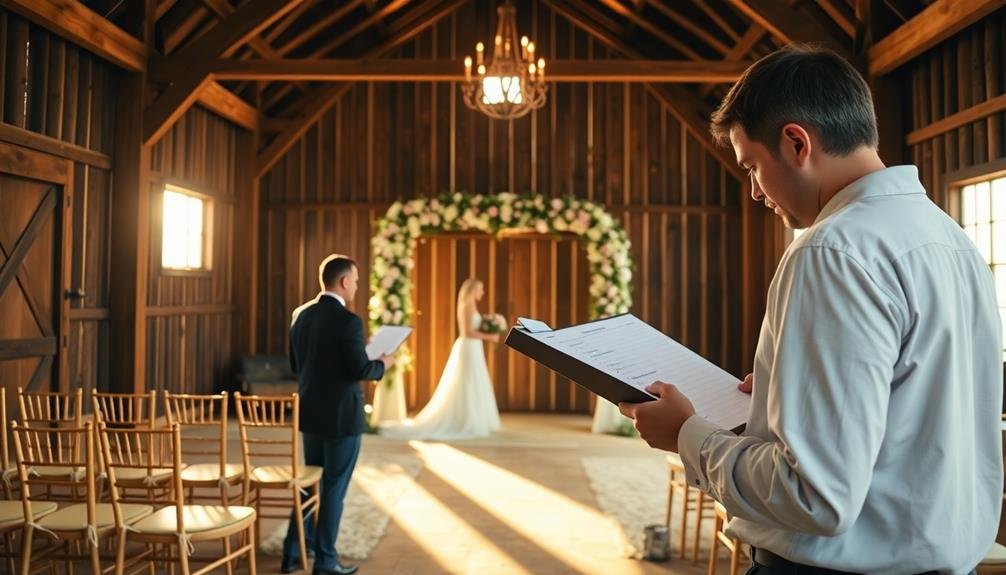
Once you've identified all the key moments and personal touches to capture, it's time to create a thorough shot schedule. This timeline will help you stay organized and guarantee you don't miss any vital shots during the wedding day.
Start by consulting with the couple and wedding planner to get a detailed itinerary of the event. Use this information to map out your photography plan, allocating specific time slots for each type of shot.
Consider the following when creating your shot schedule:
- Lighting conditions throughout the day
- Location changes and travel time between venues
- Time needed for setup and breakdown of equipment
Be sure to build in buffer time for unexpected delays or spontaneous photo opportunities. It's also wise to prioritize the most important shots earlier in the day when everyone is fresh and looking their best.
Remember to account for family groupings, wedding party photos, and couple portraits.
Communicate your schedule with the couple and other vendors to guarantee everyone's on the same page. This coordination will help the day run smoothly and allow you to capture all the essential moments without feeling rushed or overwhelmed.
Communicating With Your Photography Team

With your shot schedule in place, it's time to focus on effective communication with your photography team. Share your shot list and schedule with them well in advance of the wedding day. This allows them to familiarize themselves with your vision and prepare accordingly. Encourage open dialogue and welcome their input, as they may have valuable suggestions based on their experience.
Schedule a pre-wedding meeting or call with your photographers and videographers to discuss the details. Review the shot list together, addressing any questions or concerns. Clarify your expectations for specific shots, poses, or styles you desire. Don't forget to inform them about any unique traditions or surprise elements you've planned.
| Communication Method | Timing | Purpose |
|---|---|---|
| 2-4 weeks before | Share shot list and schedule | |
| Phone call | 1-2 weeks before | Discuss details and answer questions |
| In-person meeting | Week of wedding | Final walkthrough and adjustments |
| Day-of briefing | Wedding day | Last-minute updates and reminders |
On the wedding day, designate a point person to liaise with the photography team. This individual can help coordinate group shots, guarantee the schedule stays on track, and communicate any last-minute changes. By maintaining clear and constant communication, you'll help your photography team capture all the special moments of your small wedding seamlessly.
Frequently Asked Questions
How Many Photographers/Videographers Should We Hire for a Small Wedding?
For a small wedding, you'll typically need one photographer and one videographer. However, if you want more extensive coverage, consider hiring a second shooter. It's best to discuss your specific needs with potential professionals to determine the ideal team size.
What Backup Equipment Should Photographers Bring to a Small Wedding?
You'll want to bring extra cameras, lenses, batteries, and memory cards. Don't forget backup lighting equipment, tripods, and flash units. It's also wise to pack chargers, lens cleaning supplies, and a laptop for on-site backups.
How Long Does It Typically Take to Receive the Final Edited Photos/Videos?
You'll typically receive your final edited photos within 4-8 weeks after your wedding. For videos, it's often 8-12 weeks. However, timelines can vary depending on the photographer's workload and your package's specifics. Don't hesitate to ask for updates.
Should We Provide a Meal for Our Photography/Videography Team During the Reception?
You should provide a meal for your photography/videography team during the reception. It's common courtesy and keeps them energized. They'll appreciate the gesture and be more likely to capture your special moments throughout the event.
What's the Best Way to Share Our Wedding Photos With Guests Afterward?
You've got several great options to share your wedding photos with guests. Consider creating a private online gallery, sending digital albums via email, or using a photo-sharing app. You can also provide USB drives with selected images as keepsakes.
In Summary
You've now got an extensive shot list for your small wedding photography and videography. Remember, it's your day, so don't hesitate to customize this list to fit your unique vision. Communicate clearly with your photography team, prioritize the shots that matter most to you, and stay flexible. With careful planning and a talented team, you'll capture beautiful memories that you'll cherish for years to come. Enjoy your special day!

I’m Sarah, the creator and writer behind this site. I’m a wife and a mother of two wonderful kids who keep me on my toes and inspire me daily. My passion lies in creating and organizing memorable events and group activities, where people can come together and make lasting memories.

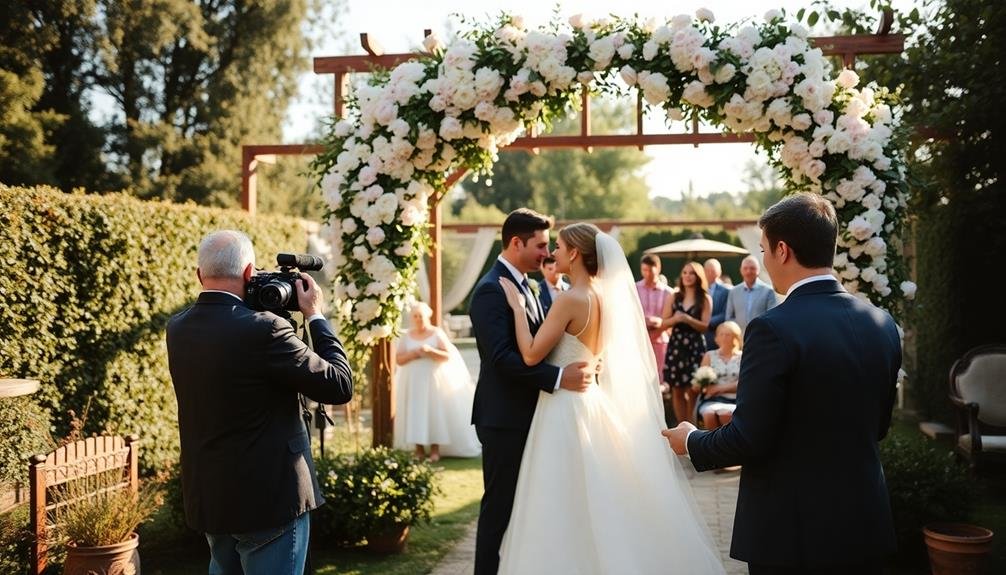



Leave a Reply